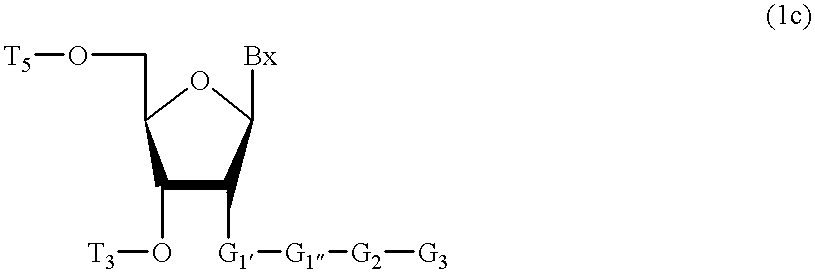Compositions and methods for modulating RNA
a technology of rna and rna ligand, applied in the direction of peptide/protein ingredients, peptide sources, genetic material ingredients, etc., can solve the problems of insufficient activity of antisense oligonucleotides presently available, insufficient for effective therapeutic, research reagent, diagnostic use in any practical sense, etc., to achieve the effect of expanding the polyamino function
- Summary
- Abstract
- Description
- Claims
- Application Information
AI Technical Summary
Benefits of technology
Problems solved by technology
Method used
Image
Examples
example 2
9-(2-(O-2-propynyloxy)-3,5-O-tetraisopropyldisiloxanyl-.beta.-D-ribofuranosyl)adenine, 4
Adenosine (10.7 g, 40.0 mmol) was dissolved in hot anhydrous DMF (200 mL) under an argon atmosphere, the solution was cooled to 5.degree. C., and NaH (1.76 g, 44 mmol) was added as a 60% dispersion in oil. The reaction mixture was stirred at ambient temperature for 30 min after which time propargyl bromide (4.90 mL, 44 mmol) as an 80% solution in toluene was added via syringe. After the reaction mixture was stirred for 24 hours the solvent was evaporated in vacuo (1 torr) at 40.degree. C. to give a gum. This crude mixture was dried in vacuo (1 torr) at ambient temperature for 18 hours, evaporated with anhydrous pyridine twice, then partially dissolved in hot anhydrous pyridine (120 mL). 1,3-Dichlorotetraisopropyl disiloxane (14.35 mL, 45.6 mmol) was added and the reaction mixture was stirred at ambient temperature for 4 hours and the solvent was evaporated in vacuo (1 torr) at 40.degree. C. to gi...
example 3
2-(7-t-Butyldimethylsilyloxy)naphthyl trifluoromethane-sulfonate, 5
Compound 22 (8.00 g, 27.4 mmol) was dissolved in anhydrous pyridine (120 mL) under an argon atmosphere and t-butyldimethylchlorosilane (5.37 g, 35.6 mmol) was added. The reaction mixture was stirred at ambient temperature for 24 hours, poured into water (120 mL), and extracted with ether (3.times.120 mL). The organic phase was separated and washed with water (120 mL), aqueous 10% HCl (120 mL), water (120 mL), and brine (120 mL). After separation, the organic phase was dried with MgSO.sub.4 and the solvent was evaporated in vacuo to give an oil, which was purified by column chromatography using hexane-EtOAc, 90:10, as eluent. The title compound was obtained as an oil (8.10 g, 73%). .sup.1 H-NMR (200 MHz, CDCl.sub.3): d 7.86 (m, 6, HAr), 1.02 (s, 9, Me.sub.3), 0.26 (s, 6, CH.sub.3).
example 4
9-((4-(7-(2-O-t-butyldimethylsilyloxy)naphthyl)-O-2-propy-nyloxy-)-3,5-O-tetraisopropyldisiloxanyl-.beta.-D-ribofuranosyl))adenine, 6
Compound 4 (1.052 g, 1.92 mmol), compound 5 (780 mg, 1.92 mmol), tetrakis (triphenylphosphine)palladium(0) (222 mg, 0.192 mmol), CuI (73 mg, 0.384 mmol), and NEt.sub.3 (0.54 mL, 3.84 mmol) were stirred in anhydrous DMF (10 mL) under an argon atmosphere at ambient temperature. After 3 hours the solvent was evaporated in vacuo (1 torr) at 40.degree. C. to give an oil which was dissolved in EtOAc. The organic phase was washed with water, dried with MgSO.sub.4, and the solvent was evaporated in vacuo to give a foam. The product was purified by column chromatography using hexane-EtOAc, 50:50, to give the title compound 6 as a foam (1.26 g, 83%). .sup.1 H-NMR (200 MHz, CDCl.sub.3): d 8.28 (s, 1, H8), 8.10 (s, 1, H2), 7.72-7.04 (m, 6, HAr), 6.11 (s, 1, H1'), 5.60 (br s, 2, NH), 4.85 (ABq, 2, OCH.sub.2 CC, J=15.8 Hz), 4.83 (m, 1, H3'), 4.68 (d, 1, H2'), 4.21 (...
PUM
| Property | Measurement | Unit |
|---|---|---|
| temperature | aaaaa | aaaaa |
| temperature | aaaaa | aaaaa |
| temperature | aaaaa | aaaaa |
Abstract
Description
Claims
Application Information
 Login to View More
Login to View More - R&D
- Intellectual Property
- Life Sciences
- Materials
- Tech Scout
- Unparalleled Data Quality
- Higher Quality Content
- 60% Fewer Hallucinations
Browse by: Latest US Patents, China's latest patents, Technical Efficacy Thesaurus, Application Domain, Technology Topic, Popular Technical Reports.
© 2025 PatSnap. All rights reserved.Legal|Privacy policy|Modern Slavery Act Transparency Statement|Sitemap|About US| Contact US: help@patsnap.com



